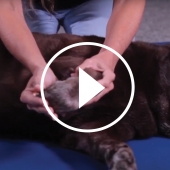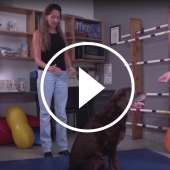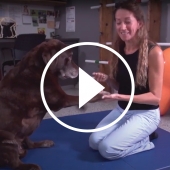“Cats and dogs communicate pain differently from humans and it often takes some time before owners realize their pet needs assistance,” says Dr. Sarah Myers, veterinarian. With many people now working from home, pet owners have a chance to recognize sooner their four-legged friend's pain signs. Here are some signs to watch out for.
Pets react to pain differently
Tolerance for pain varies greatly. Some cats and dogs can be very vocal from a mild discomfort, while others will only whine while experiencing severe pain. It may be obvious that an animal has difficulty climbing the stairs … but it can be tricky to notice they’re avoiding specific activities like jumping, grooming themselves or eating comfortably. “The key is knowing your pet’s normal behaviour, appetite and energy level,” says Dr. Myers. “This establishes a baseline to recognize when something’s off, especially subtle changes happening gradually.”
Common pain signs in pets
In both cats and dogs, obvious pain signs such as heavy or laboured breathing, whimpering or crying and trembling could indicate a pet is in serious pain and that you should contact your veterinary clinic immediately. More subtle signs to keep an eye for include a decrease in appetite or activity, restlessness and any unusual mood or personality change.
Cats tend to hide their pain
When experiencing pain, a cat’s instinct is often to avoid attracting attention from potential predators. They may act grumpier or more reserved than usual, or hide in dark places like under the bed or inside a closet. They may sleep less (because the pain keeps them awake) or more than usual (if they feel exhausted), neglect grooming themselves or stop using their litter box.
Signs a dog may be in pain
Dogs may display signs of localized pain by gnawing or licking at a particular area of the body, or limping. They may also seem less active and less energetic than usual when playing or going for a walk, or be more protective of certain body parts when being groomed or petted. They may avoid stairs or have a hard time jumping into or out of a vehicle.
Finding the cause of pain
Pain can be caused by many issues, ranging from early periodontal disease, soft tissue injuries, mild skin irritations, broken teeth and infections to physical trauma and underlying conditions, such as osteoarthritis. “Regular grooming and brushing are a great time to examine your pet’s paws, belly, ears and jaw for any visible signs of injury,” recommends Dr. Myers. “Watch out for body parts that appear unusually warm to the touch or swollen, which could indicate an infection or inflammation.”
If you suspect your pet may be in pain, a physical examination by your veterinarian is the most efficient way of discovering the cause. Keep track of any changes in your pet’s normal state and of any activities they’ve stopped doing to provide your veterinarian with more information. This could be in the form of written notes, or ideally, videos recorded on your phone. Depending on their observations, your veterinarian may recommend additional tests such as X-rays or ultrasounds to determine the appropriate treatment, like a diet change, surgery, medication or supplements, such as Flexadin for osteoarthritis.






